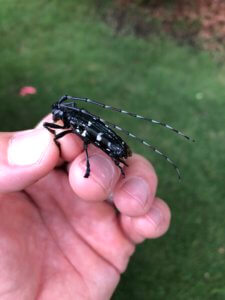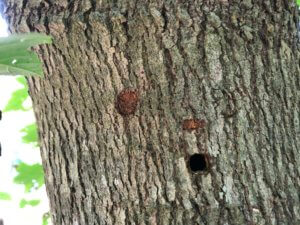In late May 2020, an observant resident of Hollywood, SC noticed and reported an unusual black and white spotted beetle near a porch light at their home. That beetle unfortunately turned out to be one of many Asian longhorned beetles infesting trees in the area, and USDA APHIS is now working with the Clemson Department of Plant Industry and Clemson Extension to understand the geographic scope of the infestation, as well as how the beetle is spreading in this coastal South Carolina habitat.

There are two important things that anyone in the southeastern US can do to help. Report any possible sightings of this beetle, and don’t move any wood or tree products (firewood, chips, branches, yard waste) around the greater Charleston area.
Take a look at the trees around you, and report any insects you might find that look like this beetle- or any potential holes or other damage that might be from the Asian longhorned beetle. The beetles themselves are about 1” to 1.5” long, have a very long black and white striped antenna, and a black glossy body with obvious white spots. Sometimes they look like they have blue-ish feet. Beetles make several different types of damage on trees, including round, ¼” to 3/8” holes and small chewed “divots” on the outside of the tree. Bark may split in some places and the tree may ooze fluid around these areas. Branches will often fall from the tree, as feeding from the larvae weakens the structural integrity of the tree. So far, in this area, damage has been most commonly seen on red maples. More information on the ALB can be found on the Asian longhorned beetle Clemson Extension fact sheet. If you think you see an ALB, please capture the insect or take a photo and contact the Clemson Department of Plant Industry (invasives@clemson.edu or by calling 864-646-2140) or your local Clemson Extension office, which can be found here: https://www.clemson.edu/extension/co/index.html. If you think you have found an ALB outside of South Carolina, please visit the AsianLonghornedBeetle.com Report It form.

Firewood, yard waste, and other wood and tree products could potentially contain beetles. Don’t take firewood from your backyard along with you when you go camping, fishing, or any activity where you might use firewood. Instead, buy local bundled firewood at or near your destination, or gather firewood on site when you get there (if that is permitted). Take care to observe any local restrictions about yard waste in the area near the newly discovered Asian longhorned beetle infested area in and around Hollywood SC (southwest of Charleston).

Co-authored by David Coyle, Clemson University, and Leigh Greenwood, The Nature Conservancy



